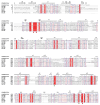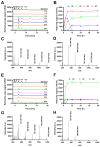Expression and characterization of a novel microbial GH9 glucanase, IDSGLUC9-4, isolated from sheep rumen
- PMID: 38810985
- PMCID: PMC11366526
- DOI: 10.5713/ab.24.0138
Expression and characterization of a novel microbial GH9 glucanase, IDSGLUC9-4, isolated from sheep rumen
Abstract
Objective: This study aimed to identify and characterize a novel endo-β-glucanase, IDSGLUC9-4, from the rumen metatranscriptome of Hu sheep.
Methods: A novel endo-β-glucanase, IDSGLUC9-4, was heterologously expressed in Escherichia coli and biochemically characterized. The optimal temperature and pH of recombinant IDSGLUC9-4 were determined. Subsequently, substrate specificity of the enzyme was assessed using mixed-linked glucans including barley β-glucan and Icelandic moss lichenan. Thin-layer chromatography (TLC), high-performance liquid chromatography (HPLC), matrix assisted laser desorption ionization time of flight mass spectrometry analyses were conducted to determine the products released from polysaccharides and cello-oligosaccharides substrates.
Results: The recombinant IDSGLUC9-4 exhibited temperature and pH optima of 40°C and pH 6.0, respectively. It exclusively hydrolyzed mixed-linked glucans, with significant activity observed for barley β-glucan (109.59±3.61 μmol/mg min) and Icelandic moss lichenan (35.35±1.55 μmol/mg min). TLC and HPLC analyses revealed that IDSGLUC9-4 primarily released cellobiose, cellotriose, and cellotetraose from polysaccharide substrates. Furthermore, after 48 h of reaction, IDSGLUC9-4 removed most of the glucose, indicating transglycosylation activity alongside its endo-glucanase activity.
Conclusion: The recombinant IDSGLUC9-4 was a relatively acid-resistant, mesophilic endo-glucanase (EC 3.2.1.4) that hydrolyzed glucan-like substrates, generating predominantly G3 and G4 oligosaccharides, and which appeared to have glycosylation activity. These findings provided insights into the substrate specificity and product profiles of rumen-derived GH9 glucanases and contributed to the expanding knowledge of cellulolytic enzymes and novel herbivore rumen enzymes in general.
Keywords: Expression; Glycoside Hydrolase; Hydrolysis; Rumen Microbiome; β-Glucan.
Conflict of interest statement
We certify that there is no conflict of interest with any financial organization regarding the material discussed in the manuscript.
Figures







Similar articles
-
A novel bifunctional glucanase exhibiting high production of glucose and cellobiose from rumen bacterium.Int J Biol Macromol. 2021 Mar 15;173:136-145. doi: 10.1016/j.ijbiomac.2021.01.113. Epub 2021 Jan 19. Int J Biol Macromol. 2021. PMID: 33482202
-
Heterologous expression and characterization of two novel glucanases derived from sheep rumen microbiota.World J Microbiol Biotechnol. 2022 Apr 10;38(5):87. doi: 10.1007/s11274-022-03269-6. World J Microbiol Biotechnol. 2022. PMID: 35397717
-
Novel endo-(1,4)-β-glucanase Bgh12A and xyloglucanase Xgh12B from Aspergillus cervinus belong to GH12 subgroup I and II, respectively.Appl Microbiol Biotechnol. 2019 Sep;103(18):7553-7566. doi: 10.1007/s00253-019-10006-x. Epub 2019 Jul 20. Appl Microbiol Biotechnol. 2019. PMID: 31332485
-
Action of an endo-β-1,3(4)-glucanase on cellobiosyl unit structure in barley β-1,3:1,4-glucan.Biosci Biotechnol Biochem. 2015;79(11):1810-7. doi: 10.1080/09168451.2015.1046365. Epub 2015 Jun 1. Biosci Biotechnol Biochem. 2015. PMID: 26027730 Free PMC article.
-
Review: The structure and function of cellulase (endo-β-1,4-glucanase) and hemicellulase (β-1,3-glucanase and endo-β-1,4-mannase) enzymes in invertebrates that consume materials ranging from microbes, algae to leaf litter.Comp Biochem Physiol B Biochem Mol Biol. 2020 Feb;240:110354. doi: 10.1016/j.cbpb.2019.110354. Epub 2019 Oct 21. Comp Biochem Physiol B Biochem Mol Biol. 2020. PMID: 31647988 Review.
References
-
- Beckmann L, Simon O, Vahjen W. Isolation and identification of mixed linked beta -glucan degrading bacteria in the intestine of broiler chickens and partial characterization of respective 1,3-1,4-beta-glucanase activities. J Basic Microbiol. 2006;46:175–85. doi: 10.1002/jobm.200510107. - DOI - PubMed
Grants and funding
LinkOut - more resources
Full Text Sources

